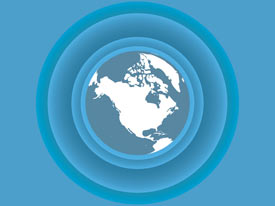The Small Business Administration, an agency of the U.S. federal government, provides support to small business entrepreneurs seeking to establish and grow their businesses. The agency focuses on what it describes as the three C’s – capital, contracts and counselling. The agency is also charged with helping regions affected by natural disasters and other crises recover economically.
History of the SBA
The Small Business Administration was an Eisenhower-era creation, coming into existance in the early 50s. The agency’s original mission was to, “aid, counsel, assist and protect, insofar as is possible, the interests of small business concerns.”
The SBA has been a political hot potato during its decades of existence, and it has come under threat of elimination or severe reduction to its loan program more than once in its nearly 60 year history. Since the election of Barack Obama, the agency has grown and has become a major source of capital for small business after the credit freeze of 2008.
Since the onset of the financial crisis, the SBA has helped small businesses secure financing by offering up to a 90 percent guarantee from the federal government to lenders. SBA loans hit record numbers in 2010.
 Loan programs
Loan programs
The SBA is perhaps best known for its loan programs. In 2010 alone, the SBA backed more than $22 billion in loans to small businesses, a total of more than 54,000 loans. Guarantees offered by the SBA made these loans attractive to lenders, who may have not made them otherwise. However, do not be confused. The SBA does not help uncreditworthy companies get loans. The SBA helps entrepreneurs by allowing them to get a larger amount of money than they might ordinarily have obtained or getting a more favorable repayment schedule.
SBA loans are frequently used to obtain commercial mortgages on small business facilities. The loans help entrepreneurs out by reducing the down payment the bank will require up front or obtaining more favorable terms on the loan. Bankers like it because they can cut their exposure to risk by taking a first-lien position in exchange for a reduced percentage of the project financed by the loan, and then obtaining the remainder of the financing by getting a SBA Certified Development Company to take a second-lien position on the loan.
Here are some of the loan programs offered by the SBA:
7(a) Loans
The 7(a) Loan Guarantee program is aimed at helping small business owners start new businesses or expand existing ventures. Entrepreneurs can get up to $5 million in funding from a 7(a) loan. The loans are guaranteed by the federal government, making them more desireable to lenders because of the reduced risk involved.
504 Fixed Asset Financing Program
This program helps businesses purchase real estate or equipment and machinery for their businesses. The program is run through non-profit Certified Development Companies scattered throughout the U.S.
Under the program, lenders provide half the loan amount, the CDC provides another 40 percent through SBA-backed financing and the entrepreneure must put up a 10 percent down payment.
The SBA has some tough criteria for the sites it will allow borrowers to purchase under the program, particularly environmental rules. The maximum amount of funding available under this program is $5.5 million.
Microloans
These tiny loans provide seed money to small businesses and are made available through non-profit financial organizations. Loan amounts top out at $50,000, but the average loan is $13,000. The money can be used for capital purchases, or purchases of supplies and materials.
Disaster Relief Loans
When natural disasters strike, small businesses can have a hard time getting back on their feet. The SBA can help by offering long-term, low-interest loans for rebuilding and repair. SBA loans are also available to homeowners and renters.
To obtain an SBA loan, the borrower must have their repayment ability and assets reviewed by the SBA. Typical turnaround for SBA disaster loan applications is less than a month, however loans made in the aftermath of Hurricane Katrina took 74 days. Borrowers may be required to pledge assets as security for the loan.
When SBA disaster loans are made, the SBA releases about $14,000 of the loan to the borrower almost immediately, and subsequent disbursements of the loan contingent on the progress of the loan project’s construction and whether the borrower keeps insurance coverage on the project.
If you’re in a federally declared disaster area, and can’t get a SBA-backed loan, you may be able to secure funding from FEMA programs.
Many of the SBA’s loan programs are targeted at helping minorities and women get a leg up in business and helping develop blighted or underdeveloped areas. Many of the loans backed by the SBA require the lender to provide the business owner with some counseling or financial advice.
Entrepreneurial Development Programs
The SBA supports a number of programs intended to help entrepreneurs become more business-savvy. For example, the SBA’s Small Business Development Centers are active in about 900 locations across the nation, mostly community colleges and similar facilities. The program is partially supported by state governments. The program helps provide small business entrepreneurs with financing, management, marketing, technical assistance, etc.
The SBA also sponsors 110 Women’s Business Centers. These centers typically provide advice and assistance to women operating small, home-based businesses.
The SBA also provides funds to support the activities of 350 chapters of the Service Corps of Retired Executives, which provide mentoring from experienced executives to younger entrepreneurs.
Federal contracts
The SBA also helps small businesses obtain federal contracts. The 8a Business Development program helps women and minorities who own businesses obtain federal contract work by providing training and mentoring and by allowing them to team bid with other minority or woman-owned businesses to bid on projects.
The HUBzone program exists to help businesses in underutilized or disadvantaged areas get government contracts, thus spurring investment in these areas. To qualify, businesses must have offices located in designated HUBzones and employ workers who live in HUBzones.
Online resources
The SBA maintains an excellent website, http://www.sba.gov, that provides a wealth of knowledge for business owners seeking information about budgeting, marketing, financial management, taxes and more. The site also can help you find local SBA services, such as development centers and lenders.
Small business owners can get the most out of the SBA by getting in contact with an SBA representative and finding out what the SBA can offer their specific business. Representatives can help entrepreneurs receive the capital, training and leg up on government contracts that today’s highly competitive business environment requires.
Entrepreneurs starting their first small business are encouraged to take advantage of Small Business Administration training programs that may be available in their community. These programs provide quality advice from experienced professionals and can greatly help to reduce the learning curve many small business owners face when they start their first ventures into entrepreneurship.
The SBA can be an incredible information and financing resource for small business owners seeking to start a new business or retool to become more competitive. By checking into what the SBA can do for you, you can potentially gain access to a wealth of mentoring and help with lenders.










